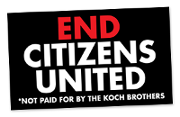Biblio
Filters: First Letter Of Last Name is K [Clear All Filters]
(2009). Michael Moore: America's Teacher.
"But we spend eight to ten to twelve hours of our daily lives at work, where we have no say. I think when anthropologists dig us up 400 years from now—if we make it that far—they're going to say, 'Look at these people back then. They thought they were free. They called themselves a democracy, but they spent ten hours of every day in a totalitarian situation and they allowed the richest 1 percent to have more financial wealth than the bottom 95 percent combined.'
Truly they're going to laugh at us the way we laugh at people 150 years ago who put leeches on people's bodies to cure them."
Truly they're going to laugh at us the way we laugh at people 150 years ago who put leeches on people's bodies to cure them."
(2007). 30 reasons employees hate their managers: what your people may be thinking and what you can do about it.
"Employment is a form of slavery. This is a provocative analogy and may be offensive to some, but it is key to understanding why employees are often unhappy.
Merriam Webster defines a slave as, 'a person who has lost control of himself or herself and is dominated by something or someone else.' This is precisely what happens in the workplace. Many employees, shackled to their jobs with little freedom to control their day-to-day work or career, feel like slaves." (p. 7)
Merriam Webster defines a slave as, 'a person who has lost control of himself or herself and is dominated by something or someone else.' This is precisely what happens in the workplace. Many employees, shackled to their jobs with little freedom to control their day-to-day work or career, feel like slaves." (p. 7)
(2003). Beyond Blame: How to Resolve Conflicts with Friends, Lovers, and Co-Workers.
"Avoid even the appearance of blame. No surprise here. This is, after all, the main theme of this book....
"There is nothing that will sabotage any strategy you employ more quickly than the mere suggestion that you are blaming the other person for the troubles. Equally detrimental is for you to accept blame that is directed toward you. This compliance tactic (perhaps even driven by the misguided belief that one person can be at fault in a conflict) will only encourage further fault-finding in the future." (p. 223)
"There is nothing that will sabotage any strategy you employ more quickly than the mere suggestion that you are blaming the other person for the troubles. Equally detrimental is for you to accept blame that is directed toward you. This compliance tactic (perhaps even driven by the misguided belief that one person can be at fault in a conflict) will only encourage further fault-finding in the future." (p. 223)
(1988). The Constraints of Corporate Tradition: Doing the Correct Thing Not Just What the Past Dictates.
But when boosting productivity comes to mean in practice nothing more than an efficiency-driven effort to cut costs and do better with line workers what is now being done, we can watch the coral build up before our very eyes. In an earlier environment, the link between old-fashioned, direct labor-based productivity and competitive strength was obvious and immediate. Today, that linkage is more complicated and less certain. Doing the right things is every bit as important as doing things right. Time was, we could think of direct-labor productivity as a pretty fair approximation of competitiveness and be confident we were on the mark. No longer. The proxy does not hold. Forgetful that it was—and is—but a proxy that holds for some circumstances but not all, many of today's managers treat as a living fact what is no more than the hard shell of past experience.
So it is with most of the maps by which managers steer. What was once known to be an artifice, though no less useful for that, gradually loses its air of being an imaginatively constructed thing and, equally gradually, takes on the air of being something real and hard and concrete in its own right." (p. 13)
So it is with most of the maps by which managers steer. What was once known to be an artifice, though no less useful for that, gradually loses its air of being an imaginatively constructed thing and, equally gradually, takes on the air of being something real and hard and concrete in its own right." (p. 13)
(1993). The Creative Spirit.
"'Love is not a word people talk about easily', says Larry Wilson, 'Yet, increasingly, we're seeing that people are wanting to know that somebody cares about them, that they are not just seen as some interchangeable part. Real leadership is about demonstrating that your intention is to care for people and support their growth.'" (p. 139)
(1988). Database Processing.
(2001). DB2 Universal Database v7.1.
(2002). Dealing with people you can't stand: how to bring out the best in people at their worst.
"All of these intents, getting it done, getting it right, getting along, and getting appreciation have their time and place in our lives. Often, keeping them in balance leads to less stress and more success. To get it done, take care to get it done right. If you want it done right, avoid complications by making sure everyone is getting along. For a team effort to succeed, each party much feel valued and appreciated." (p. 19)
(1994). Enlightened Leadership : Getting to the Heart of Change.
"When playing the corporate game of seeing who acquires more power, who is most right, who has the best ideas, and who is going to look the best, we become reluctant to take the risk of having people do anything outside of our direct control. Therefore, we become hesitant to delegate responsibility, and stifle the creativity and effectiveness of our people. We also become less likely to take risks ourselves and tend to rely on the perceived safety of the 'way we've always done it around here.' We seek the comfort of the established methods, policies, and procedures. We lock ourselves in our own boxes." (p. 218)
(1994). The Fifth Discipline Fieldbook.
"People stay with roles that frustrate them because of the dynamics of the structure. Something about their own lives, relationships, or position makes each person 'right' for the part he plays. It all seems so predetermined, yet the factors that create this may, individually, be quite inconsequential. People may even be drawn into the roles which clash with their personalities. Then, horrifyingly, their personalities may change over time to match the role they have been given." (p. 412)
(1990). Force For Change : How Leadership Differs from Management.
"Leadership is different [from management]. Achieving grand visions despite the obstacles always requires an occasional burst of energy, the kind that certain motivational and inspirational processes can provide. Such processes accomplish their energizing effect, not by pushing people in the right direction, as a control mechanism often does, but by satisfying very basic human needs: for achievement, belonging, recognition, self-esteem, a sense of control over one's life, and living up to one's ideals. These processes touch us deeply and powerfully, and elicit a most powerful response." (p. 63)
(1990). Full catastrophe living: using the wisdom of your body and mind to face stress, pain, and illness.
"Patience is a form of wisdom. It demonstrates that we understand and accept the fact that sometimes things must unfold in their own time. A child may try to help a butterfly emerge by breaking open its chrysalis. Usually the butterfly doesn't benefit from this. Any adult knows that the butterfly can only emerge in its own time, that the process cannot be hurried." (p. 34)
(2010). Her Place at the Table: A Woman's Guide to Negotiating Five Key Challenges to Leadership Success.
"To our surprise, many of our informants reported having troubled relationships with key leaders. From their perspective, these leaders were difficult and had earned their reputations for psychologically abusive behaviors. To work with them they had to make clear—right from the start—the kind of treatment they expected (and would tolerate)." (p. 79)
(Submitted). Herman Melville / David Kirby.
(1996). Jamming: The Art and Discipline of Business Creativity.
"To provide the 'glue' that encourages loyalty, Bain makes its proprietary computer database available to its alumni and alumnae, who are free to roam the company's virtual spaces in search of information on companies, contacts, business intelligence, and new methodologies. It underscores the belief that once employed by the firm, you are always considered part of the family, and that its responsibility to you extends beyond the term of employment." (p. 127)
(C)2014 CC-BY-NC 3.0, workcreatively.org











 ]
]